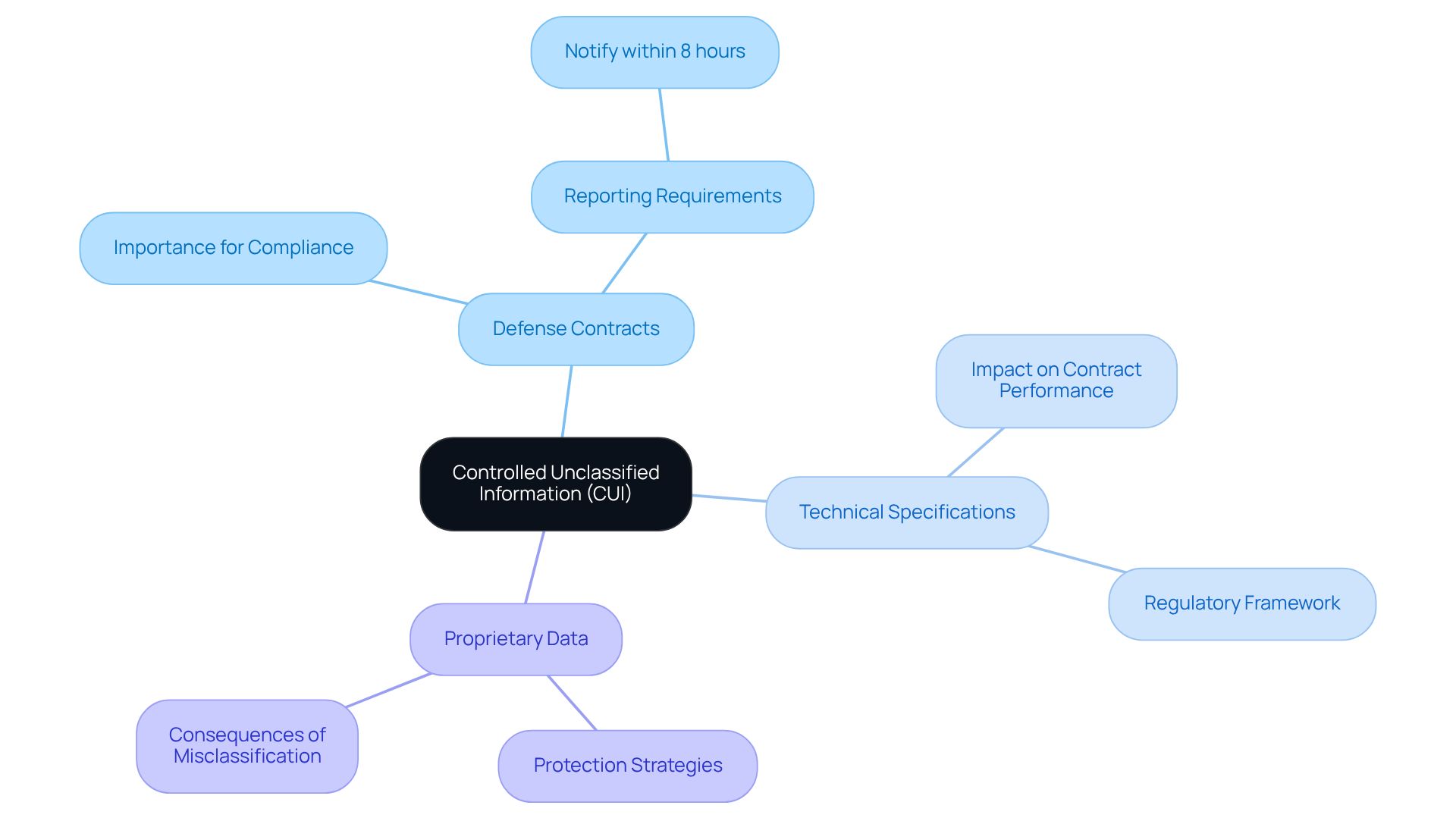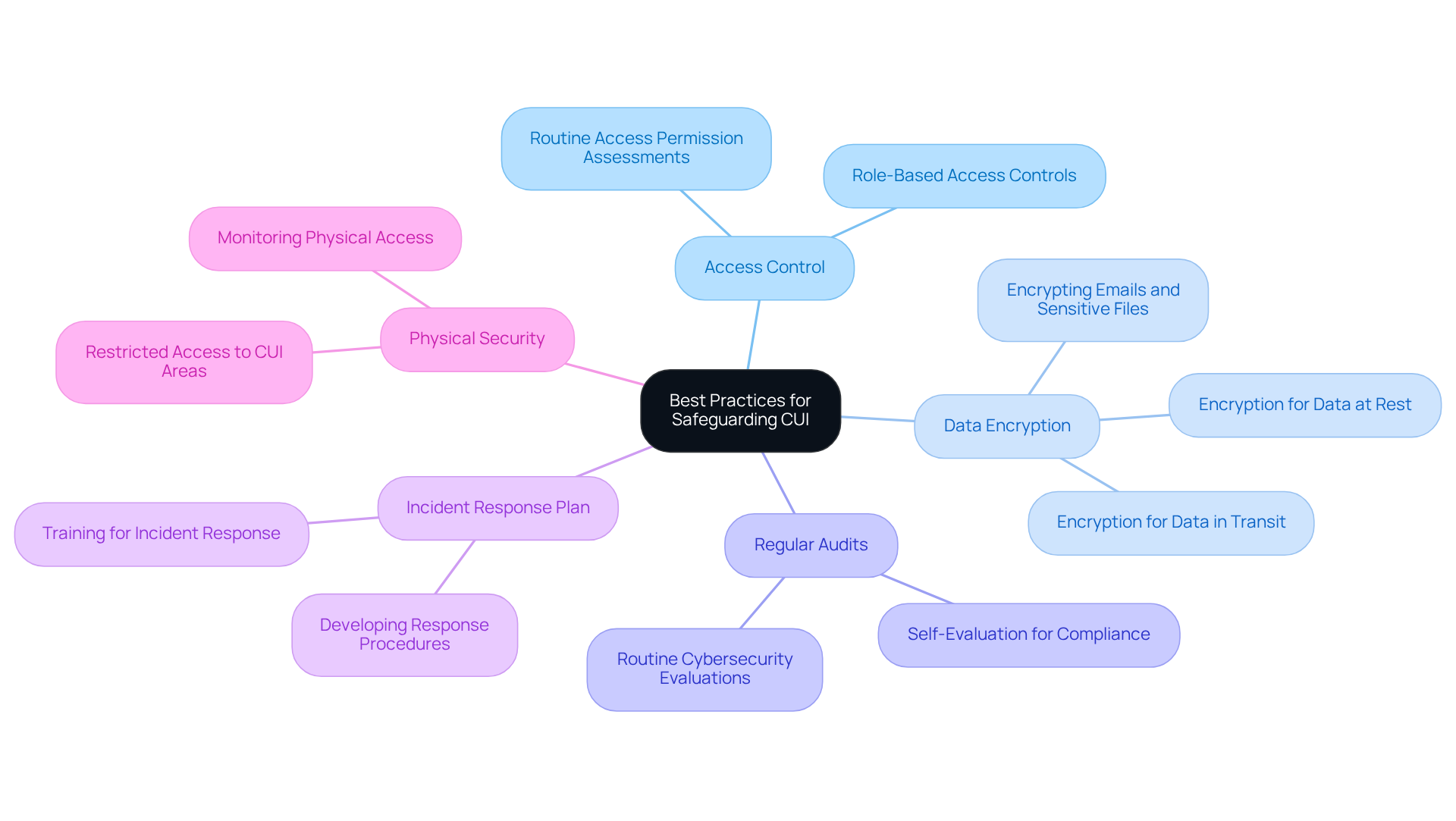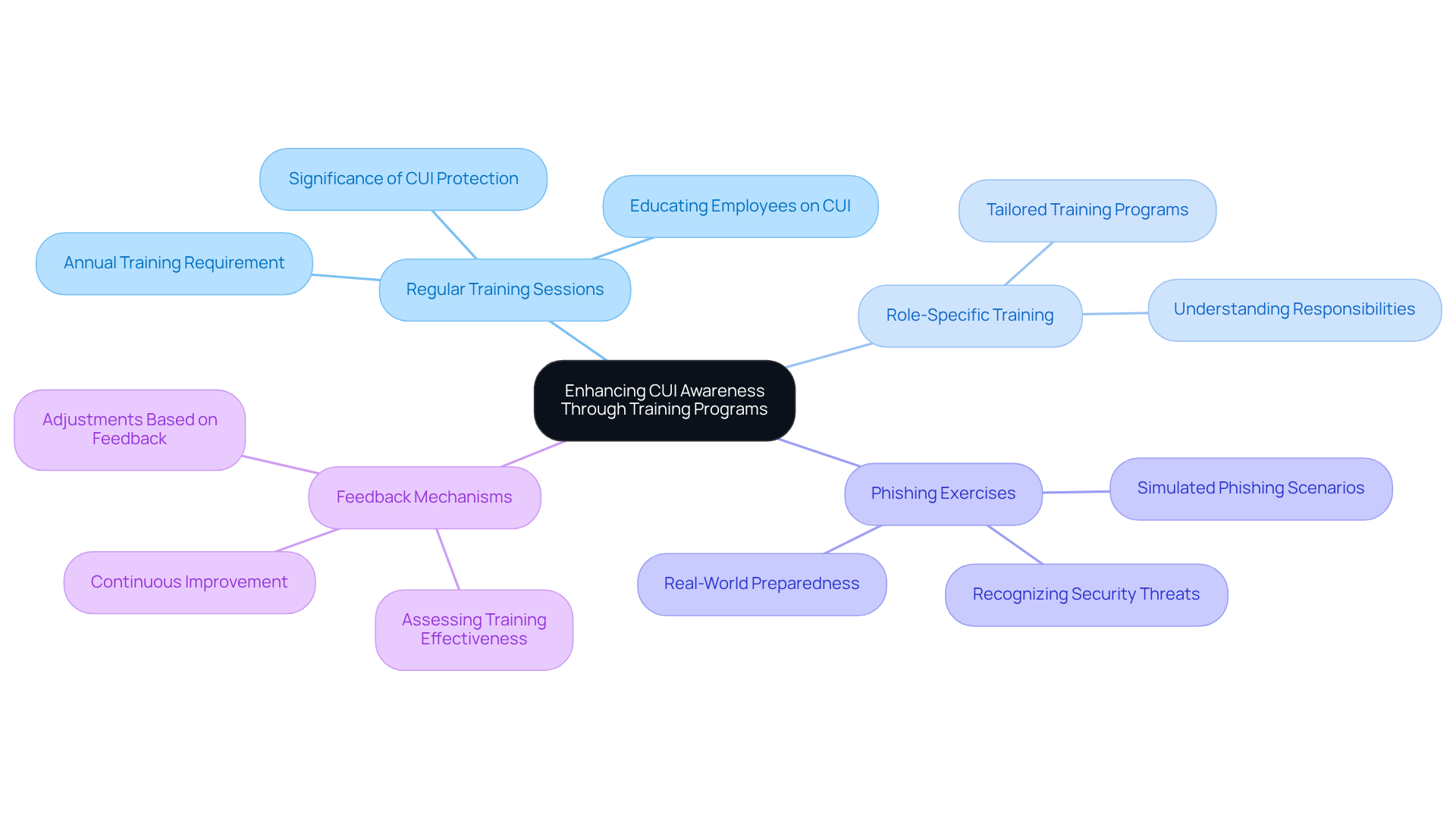Best Practices for Protecting CUI: Essential Strategies for Defense Contractors
Essential strategies for protecting CUI are vital for defense contractors to safeguard sensitive information.

Overview
The article emphasizes best practices for safeguarding Controlled Unclassified Information (CUI) specifically for defense contractors. Regulatory compliance is paramount, and effective safeguarding strategies are crucial in this endeavor. Key measures include:
- Implementing stringent access controls
- Conducting regular audits
- Providing comprehensive training programs
These actions collectively enhance security and ensure adherence to standards such as the Cybersecurity Maturity Model Certification (CMMC).
Are you aware of the specific requirements for protecting CUI? Understanding and implementing these practices not only fortifies your organization’s security posture but also aligns with regulatory expectations. By prioritizing compliance, defense contractors can mitigate risks associated with data breaches and unauthorized access.
To achieve this, it is essential to establish robust access controls that limit information access to authorized personnel only. Regular audits serve as a critical tool for identifying vulnerabilities and ensuring that security measures are effectively enforced. Additionally, comprehensive training programs empower employees with the knowledge necessary to recognize and respond to potential threats.
In conclusion, adopting these best practices for CUI protection is not merely a suggestion—it is a necessity for defense contractors aiming for compliance with CMMC standards. By taking proactive steps now, organizations can safeguard sensitive information and enhance their overall security framework.
Introduction
Understanding the nuances of Controlled Unclassified Information (CUI) is crucial for defense contractors navigating a landscape filled with regulatory complexities and security threats. Organizations striving to protect sensitive data while maintaining compliance not only gain legal protection but also secure a competitive edge in obtaining contracts. However, the challenge remains: how can defense contractors effectively implement best practices to safeguard CUI amidst evolving cybersecurity threats?
This article delves into essential strategies for protecting CUI, offering insights that can help organizations bolster their defenses and ensure compliance. By exploring these strategies, defense contractors can enhance their understanding of CUI, mitigate risks, and position themselves advantageously in a competitive market.
Define Controlled Unclassified Information (CUI)
Controlled Unclassified Information (CUI) is critical data that requires safeguarding or dissemination controls, yet it does not fall under the classification of Executive Order 13526 or the Atomic Energy Act. This category includes sensitive, unclassified information related to:
- Defense contracts
- Technical specifications
- Proprietary data
For defense contractors, understanding the specific types of CUI is essential. This understanding directly influences the strategies and obligations mandated by the regulatory framework for protecting CUI. Misclassification or misunderstanding of CUI can lead to significant compliance issues and potential penalties. Therefore, it is imperative for organizations to fully comprehend the nature and stipulations of CUI for protecting CUI, ensuring adherence, and avoiding repercussions.

Understand Regulatory Requirements for CUI Protection
Defense contractors must comply with various regulatory standards for protecting CUI, primarily detailed in the Cybersecurity Maturity Model Certification (CMMC) framework and NIST SP 800-171. These regulations mandate that organizations implement specific security controls aimed at protecting CUI from unauthorized access and disclosure. Key requirements include:
- Access controls
- Incident response plans
- Regular security assessments
Why is this important? Understanding these regulations not only helps organizations avoid penalties but also strengthens their overall cybersecurity posture. For instance, a defense contractor that neglects to establish sufficient access controls may encounter serious consequences during regulatory evaluations, jeopardizing their ability to secure future contracts.
Furthermore, utilizing trustworthy resources such as the Info Hub can provide essential guidance and insights on best practices for adherence. This ensures that defense contractors are well-prepared to meet regulatory standards and maintain compliance effectively.

Implement Best Practices for Safeguarding CUI
To safeguard Controlled Unclassified Information (CUI), defense contractors must implement best practices that align with the ultimate guide to achieving CMMC compliance:
-
Access Control: Limit access to CUI to only those individuals who require it for their work. Establish role-based access controls and routinely assess access permissions to ensure adherence to standards.
-
Data Encryption: Use encryption for CUI both at rest and in transit while focusing on protecting CUI from unauthorized access. This involves encrypting emails and files that contain sensitive information, which is crucial for protecting mandates under FAR 52.204-21.
-
Regular Audits: Perform routine evaluations and reviews of your cybersecurity practices to uncover weaknesses and guarantee adherence to applicable standards. This self-evaluation is essential for navigating Level 1 and Level 2 criteria effectively.
-
Incident Response Plan: Develop and maintain an incident response plan that outlines procedures for responding to data breaches or security incidents involving CUI. This plan is vital for ensuring a swift and effective response to potential threats.
-
Physical Security: Ensure that physical access to areas where CUI is stored or processed is restricted and monitored. This is an essential element of the technical implementation strategies required for attaining certification.
By adopting these practices, organizations can significantly reduce the risk of exposure while protecting CUI and improving their adherence to regulatory standards. This proactive approach not only safeguards sensitive information but also paves the way for successful defense contracts.

Enhance CUI Awareness Through Training Programs
To enhance awareness of Controlled Unclassified Information (CUI) protection, organizations must implement comprehensive training programs that encompass several key components:
-
Regular Training Sessions: Organizations should conduct training sessions at least annually. These sessions are essential for educating employees about CUI, its significance, and the specific measures they must take for protecting CUI.
-
Role-Specific Training: It is crucial to tailor training programs to different roles within the organization. This ensures that employees understand their specific responsibilities regarding protecting CUI, which enhances overall compliance.
-
Incorporating simulated phishing exercises can significantly aid employees in recognizing and responding to potential security threats that are crucial for protecting CUI. This proactive approach prepares them for real-world challenges.
-
Feedback Mechanisms: Establishing feedback mechanisms is vital for assessing the effectiveness of training programs. Organizations should make necessary adjustments based on employee input and evolving threats to ensure continuous improvement.
By fostering a culture of awareness and responsibility, organizations can significantly enhance their ability in protecting CUI and ensuring compliance with CMMC requirements.
Frequently Asked Questions (FAQs)
Q1: What is Controlled Unclassified Information (CUI)?
A1: CUI refers to information that requires safeguarding or dissemination controls but is not classified under executive order or statute.
Q2: Why is CUI training important for employees?
A2: Training is crucial as it ensures that employees understand the significance of CUI and the specific measures they must take to protect it, thereby reducing the risk of data breaches.
Q3: How often should CUI training be conducted?
A3: Organizations should conduct CUI training at least annually, with additional sessions as needed based on evolving threats and employee roles.

Conclusion
Protecting Controlled Unclassified Information (CUI) is a critical responsibility for defense contractors. It requires a comprehensive understanding of its definition, regulatory requirements, and best practices. Organizations must prioritize the safeguarding of CUI to ensure compliance with established frameworks and maintain their eligibility for defense contracts. Failing to adequately protect this sensitive information can lead to severe penalties and jeopardize future opportunities.
The article outlines essential strategies such as:
- Implementing robust access controls
- Conducting regular audits
- Developing incident response plans
Moreover, it emphasizes the importance of training programs tailored to various roles within the organization, ensuring that all employees are equipped to recognize and respond to potential threats. By fostering a culture of awareness and responsibility, defense contractors can significantly enhance their compliance with CMMC requirements and protect their sensitive data.
Ultimately, the responsibility of safeguarding CUI lies not just in understanding the regulations but also in actively engaging employees through training and implementing best practices. By adopting a proactive approach to CUI protection, defense contractors can not only secure sensitive information but also strengthen their overall cybersecurity posture. This proactive stance paves the way for successful and compliant operations in the defense sector.
Frequently Asked Questions
What is Controlled Unclassified Information (CUI)?
Controlled Unclassified Information (CUI) is critical data that requires safeguarding or dissemination controls but does not fall under the classification of Executive Order 13526 or the Atomic Energy Act.
What types of information are included in CUI?
CUI includes sensitive, unclassified information related to defense contracts, technical specifications, and proprietary data.
Why is it important for defense contractors to understand CUI?
Understanding CUI is essential for defense contractors as it directly influences their strategies and obligations mandated by the regulatory framework for protecting CUI.
What are the potential consequences of misclassifying or misunderstanding CUI?
Misclassification or misunderstanding of CUI can lead to significant compliance issues and potential penalties for organizations.
How can organizations ensure they are protecting CUI effectively?
Organizations can ensure they are protecting CUI effectively by fully comprehending the nature and stipulations of CUI, which helps in adhering to regulations and avoiding repercussions.




